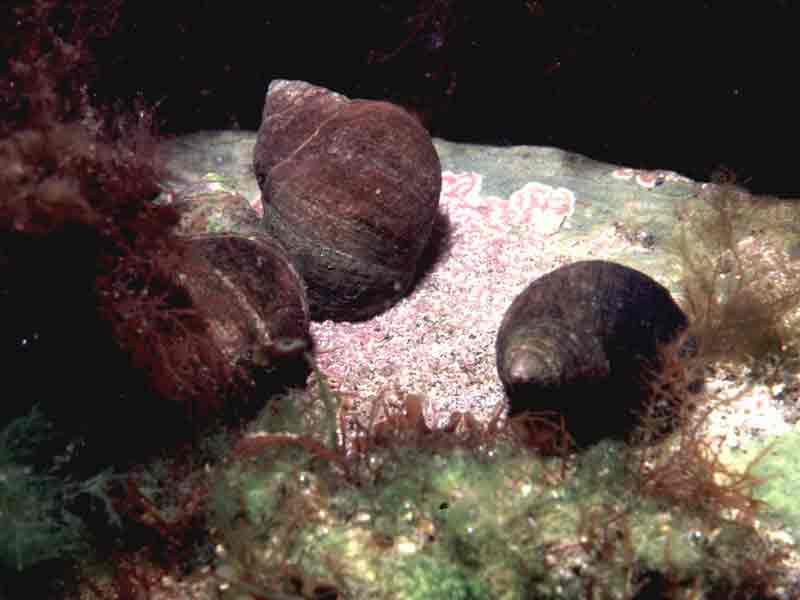Introduced Species
Summary Project
Common Periwinkle (Littorina littorea)
| Project Home | Taxonomy | Identification | Distribution | Introduction Facts | Establishment | Ecology | Benefits | Threats | Control |
Common
Name: Common Periwinkle

Scientific Name: Littorina littorea
Classification:
Phylum or Division:
Mollusca
Class: Gastropoda
Order:
Prosbranchia
Family: Neotaenioglossa
Subfamily: Littorinoide
Identification:
L. littorea
is 1.6-3.8 cm high ("Littorina
littorea" IUCN). The shell of L. littorea is sharply conical with a pointed apex and
surface
sculpturing. The smooth
shell color ranges from grey-black-brown-red but is generally black or
dark
grey-brown, and is usually patterned
with
darker spiral lines. The central axis of the shell is typically white
and the
animal is recognizable in its juvenile stages by the transverse black
barring
of the tentacles which are rather flat and broad.
Original
Distribution: L. littorea
can be found along most intertidal rocky coasts of
Current Distribution:
L.littorea can be found within
the rocky coastline, estuaries and marine habitats of
Site and
Date of
Introduction: L. littorea
was introduced from
Mode(s) of
Introduction: L. littorea
was accidentally brought from Europe to Canada through ballast water of
ships. A second possibility is that the species was brought
over for food as it is eaten in many parts of Europe. From
there L. littorea spread
south to the United States through the shipping business. Within
18 years the species spread through the whole New England coast and in
a second introduction into Maryland and Delaware, L.littorea spread throughout the
whole Atlantic coast of those states ("Littorina
littorea" Clark). Few reports have noted its spread south
of Maryland.
Reason(s) Why it has
Become Established:
Due to the ability of L. littorea to exist
in a variety of conditions it has been able to spread along rocky
coastlines at a fast rate. L.
littorea is inhabits all except the most exposed
intertidal areas;
from the upper shore into the sub littoral zones. In
sheltered conditions it can also be
found in sandy or muddy habitats such as estuaries and mud flats. The
species
is also fairly tolerant of brackish water.
The preferential food for L.
littorea is highly available along most of the Northeastern
coast of
Ecological
Role: L. littorea is an
important part of the rocky intertidal ecosystem. L.
littorea is a dominant herbivore and an important macro-algal
grazer that competes with many
local species in both  romorpha,
Ulva, and Porphyra and also diatoms.
romorpha,
Ulva, and Porphyra and also diatoms.
Benefit(s): L. littorea has been
shown to reduce the growth of the non-native Ulva lactuca
from dominating the intertidal zone in
Threat(s): L. littorea has drastically altered the
Control
Level Diagnosis: While L. littorea
has spread widely along the coasts of
Control Method:
There have been few methods of control
for L. littorea. Current eradication
ideas for a similar species Littorina saxatilis
in the
References:
“Littorina littorea" Clark University. http://www.clarku.edu/departments/biology/biol201/JDubois/Littorina%20littorea.htm
"Littorina littorea” IUCN Global Invasive Species Database http://www.issg.org
“Common
Periwinkle Littorina littorea” The
Marine Life Information Network of
(1) http://www.gastropods.com/5/Shell_995.html
(2) Clark University http://www.clarku.edu/departments/biology/biol201/Dubois/Littorina%20littorea.htm
(3) Jon Davies/JNCC (published on the MarLIN Web site)
Author:
Elizabeth Lenseth
Last Edited:
| Project Home |